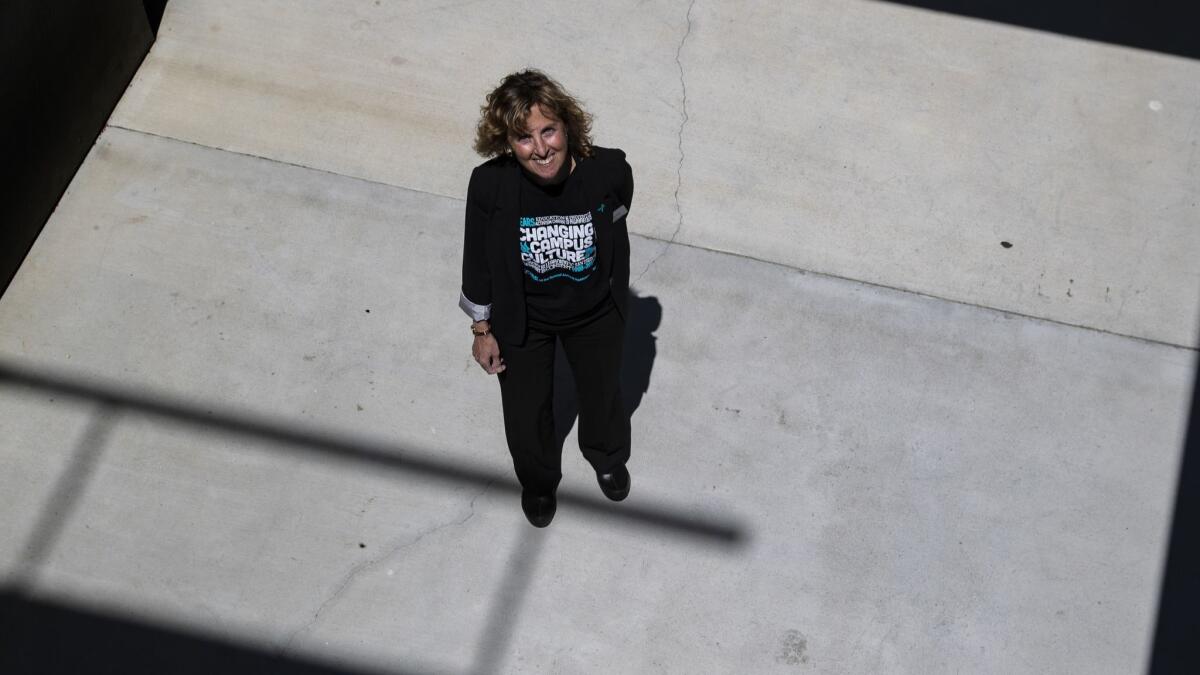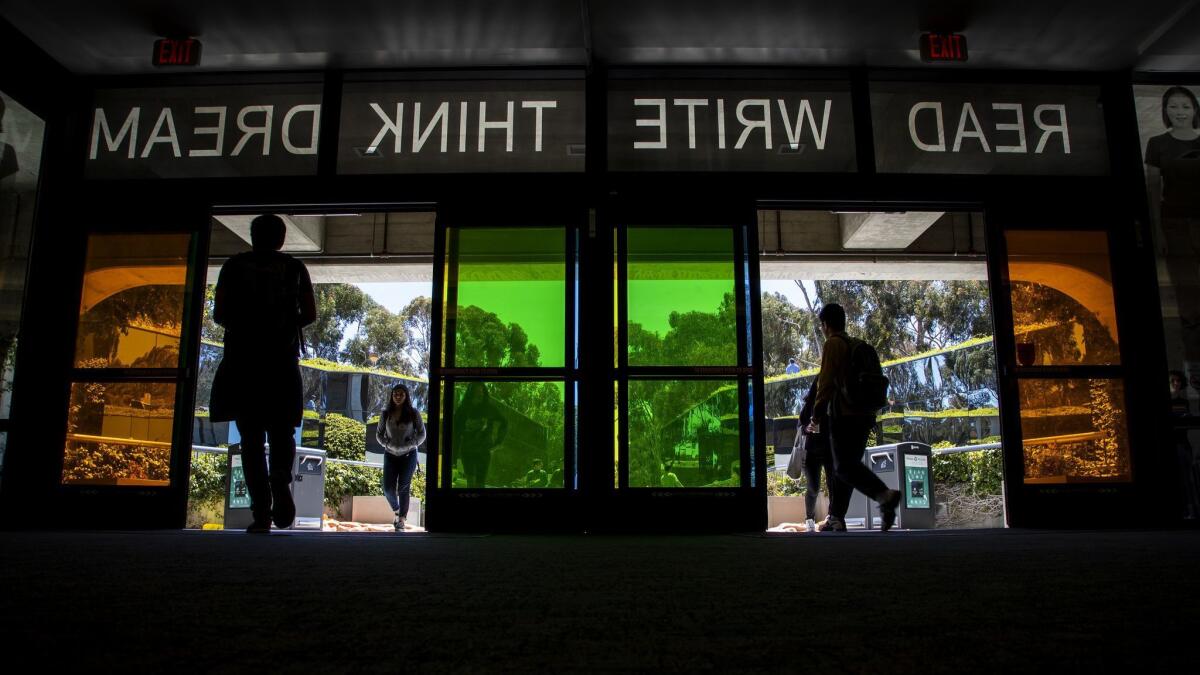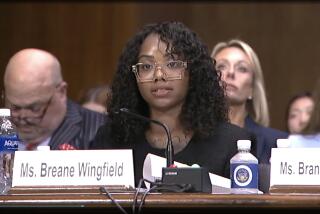Three decades before the #MeToo movement, UC San Diego led the way against sexual assault

- Share via
When Nancy Wahlig first started her fight against sexual assault, one company was marketing a capsule for women to stash in their bras and then smash to release a vile odor.
“Because of the very nature of society, the only person who can prevent rape is the woman herself,” read a 1981 advertisement for the Repulse rape deterrent.
Ideas about how to prevent sexual violence have come a long way since then, and Wahlig has helped lead that evolution on college campuses. In 1988, she started UC San Diego’s Sexual Assault Resource Center (SARC), the first stand-alone program at the University of California. Today, she remains the system’s most senior specialist.
Over the years, Wahlig, a licensed clinical social worker, has promoted a community-wide approach to prevention and watched people grow more aware of the problem. But nothing, she says, has rivaled the #MeToo and #TimesUp movements.
“We’re like a rocket, and we’re just about to take off,” she said recently. “There’s so much momentum to change the culture, and it’s not quieting down.”
This month, Wahlig’s center has been celebrating its 30th anniversary in conjunction with national Sexual Assault Awareness Month. In one of many activities, students, staff and faculty recently hand-painted pots and planted hardy succulents in them to symbolize the resilience of survivors.
Mark Anderberg, a senior in urban studies and planning, said he got a call from the center immediately after he reported that a professor at a German university had inappropriately touched him and offered sex while he was studying abroad earlier this year.
The encounter, he said, had left him traumatized and fearful. The counselor offered empathy, help day or night and gave Anderberg information about his rights.
“I felt very cared for,” he said, adding that “it’s important people know it can happen to men as well.”
Chloe Wohlenberg, a freshman in chemistry, said the practical tips she learned in the center’s presentation during orientation taught her how to help not just herself but also others.
One example: If someone at a party seems too drunk to be able to agree to a sexual encounter, interrupt and gently guide the person away.
“It was super helpful,” Wohlenberg said, as she dabbed paint on the pot for her succulent with UC colors of yellow and blue. “People are really afraid to do something.”
Wohlenberg, who says she’s never been assaulted, wears an alarm on her lanyard and says all her roommates carry pepper spray. She hopes to be a volunteer at the center next year.
In 1979, two staff members in UC San Diego’s student life and residential offices broke new ground on the campus when they began printing up information about safety and pushing for better campus lighting.

By 1987, a groundbreaking national study sparked a furor by documenting widespread date rape on college campuses, belying perceptions that strangers committed most sexual assaults.
Wahlig was hired the next year to launch the campus center, which at first was just her in a space the size of a closet.
Today, the center has six professional staff, a graduate assistant and nine student interns and volunteers. In 2016-17, they served 184 clients, held educational programs for more than 16,000 people and trained nearly 1,200 staff, faculty and student workers in ways to prevent sexual assault.
The center’s expansive offices are soundproofed, with reflective glass windows for privacy. The color scheme is soothing teal and tan, with a starfish theme because some of the marine invertebrates can regrow limbs and regenerate.
The center’s approach is grounded in the work of Alan D. Berkowitz, a psychologist who, by focusing on men’s responsibilities, helped turn around assumptions that rape was a woman’s issue. He promoted positive, inclusive and empowering practices, Wahlig said — a sharp contrast to giving women a long list of don’ts: don’t drink, don’t walk home alone.
Wahlig and her team used Berkowitz’s work to modify behavior with positive messages. In one project, they did a survey of male students and the vast majority said they would stop sexual overtures if their partner objected to them. The team plastered that finding on posters all over campus — an approach known as “social norms,” which has proved effective, Wahlig said, because most students want to conform.
The center also pioneered prevention techniques that have become common practice. In skits, they demonstrated bystander intervention — modeling how to interrupt potentially risky encounters, distract the instigators and help get peers to safety.
In the fall of 2014, UC — under President Janet Napolitano — announced a sweeping plan to combat sexual misconduct. The plan had been developed by a task force, which called on every campus to open an advocacy office called CARE, which stands for campus, advocacy, resources and education.
Wahlig’s center — officially called CARE at SARC — already was following many of the guidelines. These days, it’s not just about protecting the victim, it’s about fostering a feeling of “community responsibility,” said Jessica Heredia, the center’s assistant director.
With the support of public and private grants, her team puts on a variety of educational programs. One workshop on stalking, called “Cute or Creepy?,” sparked lively conversations about how to react to someone who sends you 100 texts in an hour.
“Cosplay and Consent,” pegged to San Diego’s annual Comic-Con, worked on breaking down false assumptions that dressing up in sexy costumes — to be Wonder Woman, for example — was like giving people invitations to grope.
For many survivors, what matters most is the personal counseling.
Esther Kim found Wahlig and the center after she was sexually assaulted in an off-campus attack in 2007. She was a junior at the time. Her grades plunged. She dropped out of school. She resisted counseling for a year. But she said Wahlig eventually won her over with compassion and candor — telling her that she would never completely heal but that she could get better.
After three years of therapy, Kim managed to graduate. She is now married, with a daughter.
“I couldn’t have gotten there without Nancy and SARC,” Kim said. “It’s having someone there just to support me.”
Twitter: @TeresaWatanabe
More to Read
Sign up for Essential California
The most important California stories and recommendations in your inbox every morning.
You may occasionally receive promotional content from the Los Angeles Times.











